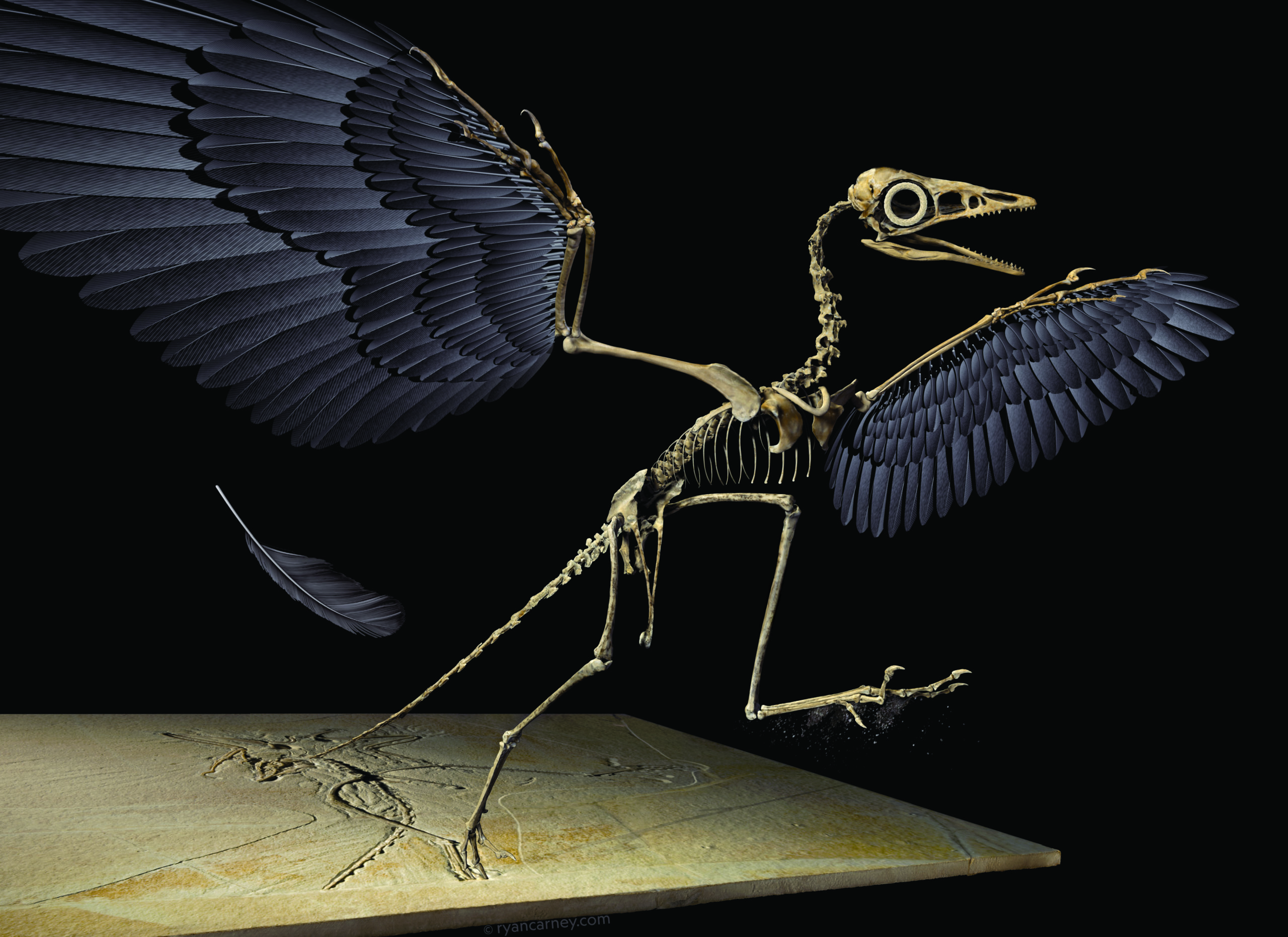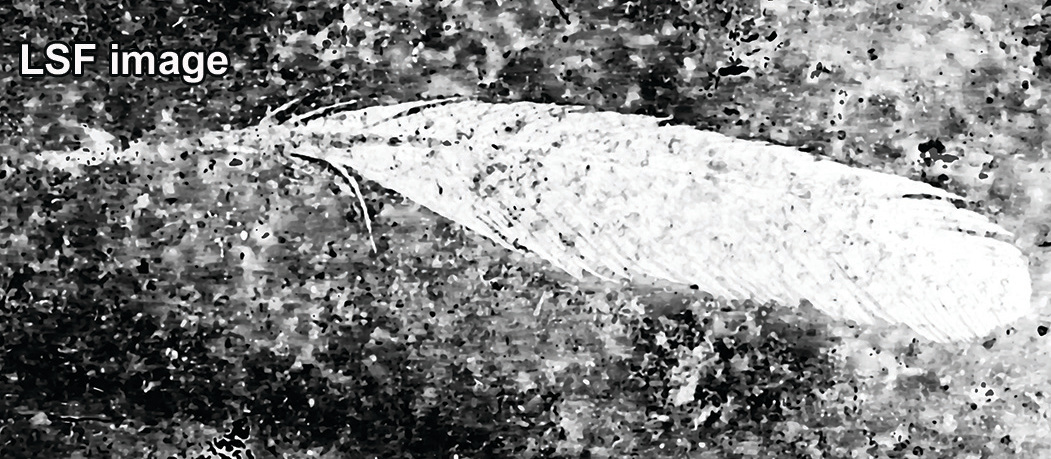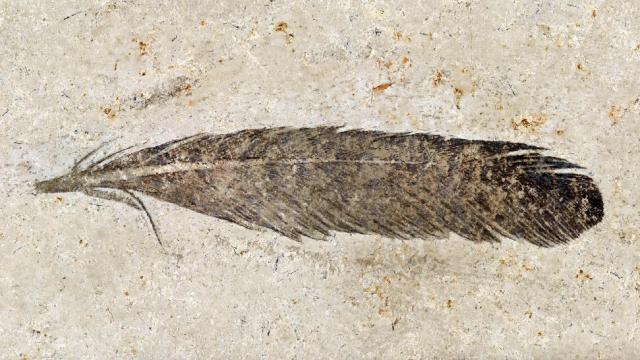A fossilised feather found 159 years ago in Germany has returned to the paleontological spotlight, with new research declaring the feather as having come from the bird-like Archaeopteryx, much to the chagrin of dissenting scientists.
When found out of context, an isolated feather fossil presents a serious headache for paleontologists. Such is the case for a 150-million-year-old feather found at a German limestone quarry in 1861. With no frame of reference, scientists couldn’t tell which species this fossil — the first dinosaur feather ever discovered — belonged to, or even which part of the body it came from.
With the discovery of an Archaeopteryx fossil a few years later, scientists naturally linked the two together. This connection wasn’t altogether outrageous, as modern scientists found other reasons to connect the iconic bird-like dinosaur to the isolated feather. Dating back to the Jurassic, Archaeopteryx represents a hugely important species, as it highlighted an important evolutionary link between dinosaurs and birds.

Last year, a research paper co-authored by paleontologist Michael Pittman from the University of Hong Kong cast some serious shade onto this assumption, concluding that the isolated feather belongs to some “unknown feathered dinosaur” and most certainly not Archaeopteryx.
Not so fast, declare an international team of scientists led by the University of South Florida. Their new paper, published today in Scientific Reports, argues that the feather does in fact belong to Archaeopteryx, as previously assumed. The new study was prompted by claims made in the Pittman paper and by other recent papers written on the topic, as Ryan Carney, the first author of the new paper and a biologist at USF, explained in an email.
“We wanted to formally address the errors and set the (fossil) record straight, so to speak,” wrote Carney. “Plus, I was a big debate nerd in high school, so I relish this sort of thing.”
Carney and his colleagues analysed nine different aspects of the fossilised feather, with special attention paid to the long quill. These details were then compared to similar anatomical features seen in modern birds. The team also studied the skeletal fossils of Archaeopteryx, of which 13 are known to exist. The researchers examined “every feather in every Archaeopteryx fossil, every single barb of the isolated feather, and every relevant piece of literature on the feather from the 1800s until today,” said Carney.
A central component of the new paper is an anatomical feature known as the primary covert. In birds, primary coverts are the shorter group of feathers tucked in close to the top edge of a wing, overlaying the longer primary feathers used for flight and gliding. The isolated feather fossil appears to be a primary covert — one that’s identical in size and shape to those seen on the top surface of the Archaeopteryx wing, according to the research. As added evidence, the team notes that the fossil feather was found near the same site in Germany that yielded four Archaeopteryx skeletons.
Based on the available evidence, “the most empirical and parsimonious conclusion is that this feather represents a primary covert from the ancient wing of Archaeopteryx,” wrote the authors in their study.
In terms of other interesting findings, the researchers believe the feather came from the animal’s left wing, and an analysis of preserved melanosomes — micro-scale pigment structures — suggests the entire feather was matte black, which contradicts previous research claiming Archaeopteryx feathers were lightly patterned.

It’s important to note that Carney’s team didn’t actually analyse the fossil itself, but rather a high-resolution digital scan of a drawing made of the fossil. German paleontologist Hermann von Meyer created the life-sized trace of the fossil in 1862 by using a drawing mirror. The digital scan allowed for “more accurate and precise measurements,” wrote the authors.
By contrast, Pittman’s team, which included Thomas Kaye from Arizona’s Foundation for Scientific Advancement, used a technique called laser-stimulated fluorescence (LSF) to create a chemical “halo” of the feather, allowing the team to see features on the fossil that would otherwise be invisible. A comparative analysis of all known feather-preserving Archaeopteryx specimens was also performed. Scientists had previously identified the feather as being an Archaeopteryx primary covert, but Pittman and his colleagues team felt their data ruled that out as a possibility.

When asked to comment on the new paper, Pittman said his team “never even considered using a drawing, since the LSF image and fossil show us primary data,” adding that the resulting data discrepancies seen in the two papers “comes from using two different data sources.” As an example, Pittman pointed to a perfectly centered line on the 1862 drawing, which doesn’t appear centered on the LSF image. It may not sound like much, but even the smallest feature can influence how other parts of the feather are interpreted, he said. Pittman believes that “science would have been better served” if Carney and his colleagues “used all available data and created error bars” to account for the most likely positions of certain features.
Carney, on the other hand, feels this debate has finally been settled.
“Given the isolated nature of the feather, we can never have absolute 100% certainty,” he said, but the “mountain of evidence speaks for itself.” What’s more, there are “no other known feathered dinosaurs at that time and place that have anything approaching the advanced stage of flight feather that this isolated feather represents,” he added.
Fair enough, but Pittman’s concerns are not without warrant. The source of this feather is clearly still controversial, so hopefully future research will to settle this debate one way or another.
It may sound superfluous to devote so much time and energy to a single feather, but as Carney pointed out, no known feathered dinosaur other than Archaeopteryx can currently account for this fossil. And if Pittman is right — that it belongs to an unknown species — it means there are some important fossils out there still waiting to be discovered.
